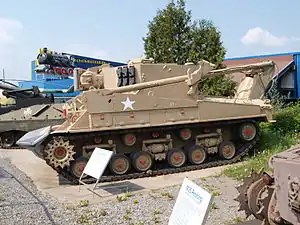M74 Armored Recovery Vehicle
The M74 tank recovery vehicle (M74)[1] was an engineer vehicle used by the U.S. Army in the 1950s. It was designed to cope with the heavier weights of the M26 Pershing and M47 Patton. It could also be suitable for light dozing, since it had a hydraulic, front-mounted spade.[2] More than 1000 were produced by Bowen-McLaughlin-York by converting M4A3 Sherman tanks starting in 1954. Later, some were converted from M32B1 ARVs by Rock Island Arsenal until 1958.[3]
| M74 Armored Recovery Vehicle | |
|---|---|
 A M74 in the Sinsheim Museum | |
| Type | Armored recovery vehicle |
| Place of origin | United States |
| Service history | |
| Used by | United States Belgium Israel Spain Portugal |
| Wars | Yom-Kippur War |
| Production history | |
| Designer | Bowen-McLaughlin-York |
| Designed | 1953 |
| Manufacturer | Bowen-McLaughlin-York |
| Produced | 1953-1958 |
| No. built | ≈1000 |
| Specifications | |
| Mass | 42.5 tons |
| Length | 7.95 m (26 ft 1 in) |
| Width | 3.10 m (10 ft 2 in) |
| Height | 3.11 m (10 ft 2 in) |
| Crew | 4 |
| Armor | 108 mm maximum |
Main armament | 1× .50 caliber Browning M2HB machine gun 1× .30 caliber Browning M1919A4 machine gun |
| Engine | Ford GAA V-8 gasoline engine 450 hp |
| Power/weight | 10.6 hp/tonne |
| Transmission | Synchromesh transmission (5 forward and 1 reverse gears) |
| Suspension | Horizontal volute spring suspension (HVSS) |
| Fuel capacity | 168 U.S. gallons (636 litres) |
Operational range | 160 km |
| Maximum speed | 34 km/h (21 mph) |
Development
After the Korean War the M74 was designed to cope with the heavier weights of the new vehicles that were being introduced.[4][5]
Designed in 1953,[6] it was based on the M4A3 HVSS medium tank and it was developed to cope with the heavier M26 Pershing and M47 Patton tanks which were entering service, which the M32 Armored Recovery Vehicle (ARV) was unable to retrieve. Using the standard Ford GAA and wide tracks, the chassis would be rebuilt. It was replaced in service with the U.S. Army by the M88 Hercules.[3][5]
Design
The M74 was fitted with a main 60,000 lb (27,000 kg)[3][5] hydraulic winch, a lighter-duty general purpose secondary winch, a hydraulic A-frame, and a hydraulic front-mounted spade, which was suitable for light dozing, as well as serving as an anchor for heavy winching operations.[2][7] It had a .50-caliber M2 machine gun atop the hull and a .30-cal M1919A4 machine gun in the right bow.
Production
_1954.jpg.webp)
Over 1000 M74 ARVs were produced between 1953 to 1955 by Bowen-McLaughlin-York. The conversion of M4A3 Sherman tanks into M74 recovery vehicles was started by Bowen in 1954.[8] Some were also converted from obsolete M32B1 ARVs by Rock Island Arsenal until 1958.[3]
Operators
 United States – Used in post-World War II Germany. It was the standard recovery vehicle of the U.S. Army in the 1950s.[5]
United States – Used in post-World War II Germany. It was the standard recovery vehicle of the U.S. Army in the 1950s.[5].svg.png.webp) Belgium - Used in 1954-198x, 56 in 1976[9]
Belgium - Used in 1954-198x, 56 in 1976[9] Israel – Used in the Yom-Kippur War[10]
Israel – Used in the Yom-Kippur War[10] Spain – Lent by the United States from 1953 to 1968.[11]
Spain – Lent by the United States from 1953 to 1968.[11] Portugal – Operated 13 units, probably from the United States, were replaced in the 1980s by 8 M88A1/A2G.[12]
Portugal – Operated 13 units, probably from the United States, were replaced in the 1980s by 8 M88A1/A2G.[12].svg.png.webp) Yugoslavia - some received during the Informbiro period[13]
Yugoslavia - some received during the Informbiro period[13]
See also
References
- Berndt, Thomas. Standard Catalog of U.S. Military Vehicles, 1940–1965. Iola, WI: Krause Publications, 1993.
- Brown, Jerold E. Historical Dictionary of the U.S. Army. Santa Barbara, CA: Greenwood Publishing Group, 2001.
- TM 9-7402 M74 Recovery Vehicle (1956)
- TM 9-7403-2 M74 Recovery Vehicle Misc. Components (1956)
Notes
- Spence. Army Vehicle Identification Numbers ISBN 0-938242-10-5
- Berndt, Thomas. Standard Catalog of U.S. Military Vehicles, 1940–1965 (Krause Publications, 1993), p. 193.
- "M74 Tank Recovery Vehicle – Olive Drab.com". Olive Drab.com LLC. October 12, 2011. Retrieved April 5, 2015.
- Conners, Chris (2011). "Medium Tank Recovery Vehicle M74". Chris Conners. Retrieved 5 April 2015.
- Skaarup, Harold (2011), p. 172.
- Brown, Jerold E. (2001). Historical Dictionary of the U.S. Army. Santa Barbara, CA: Greenwood Publishing Group. p. 27. ISBN 0-313-29322-8.
- Chant (2014), p. 21.
- Doyle, David (2011). Standard Catalog of U.S. Military Vehicles (Second ed.). Iola, WI: Krause Publications. pp. 417–418. ISBN 978-1-4402-2572-7.
- https://www.cairn.info/revue-courrier-hebdomadaire-du-crisp-1981-10-page-1.htm#no73
- Dunstan, Simon (2007), p. 92.
- Manrique, La Brunete, p. 69
- SIPRI Arms Transfers Database (PortugueseTransfers). 2019. p. 6.
- Kočevar, Iztok (August 2014). "Micmac à tire-larigot chez Tito: L'arme blindée yougoslave durant la Guerre froide" [The Yugoslav armored arm during the Cold War]. Batailles et Blindés (in French). No. 62. Caraktère. pp. 66–79. ISSN 1765-0828.
Sources
- Berndt, Thomas (1993). Standard Catalog of U.S. Military Vehicles. Iola, WI: Krause Publications. ISBN 0-87341-223-0.
- Brown, Jerold E. (2001). Historical Dictionary of the U.S. Army. Santa Barbara, CA: Greenwood Publishing Group. ISBN 0-313-29322-8.
- Chant, Christopher (2014). A Compendium of Armaments and Military Hardware (Routledge Revivals). London, UK: Routledge. p. 21. ISBN 978-1-134-64668-5.
- Dunstan, Simon (2007). The Yom Kippur War: The Arab-Israeli War of 1973. Oxford, UK: Osprey Publishing. ISBN 978-1-84603-288-2.
- Manrique, José María; Lucas Molina. La Brunete: 1ª Parte (in Spanish). Valladolid, Spain: Quirón Ediciones. p. 80. ISBN 84-96016-27-7.
- Skaarup, Harold (2011). Ironsides: Canadian Fighting Vehicles and monuments. Bloomington, IN: iUniverse. ISBN 978-1-4620-3465-9.
External links
| Wikimedia Commons has media related to M74 Tank Recovery Vehicle. |